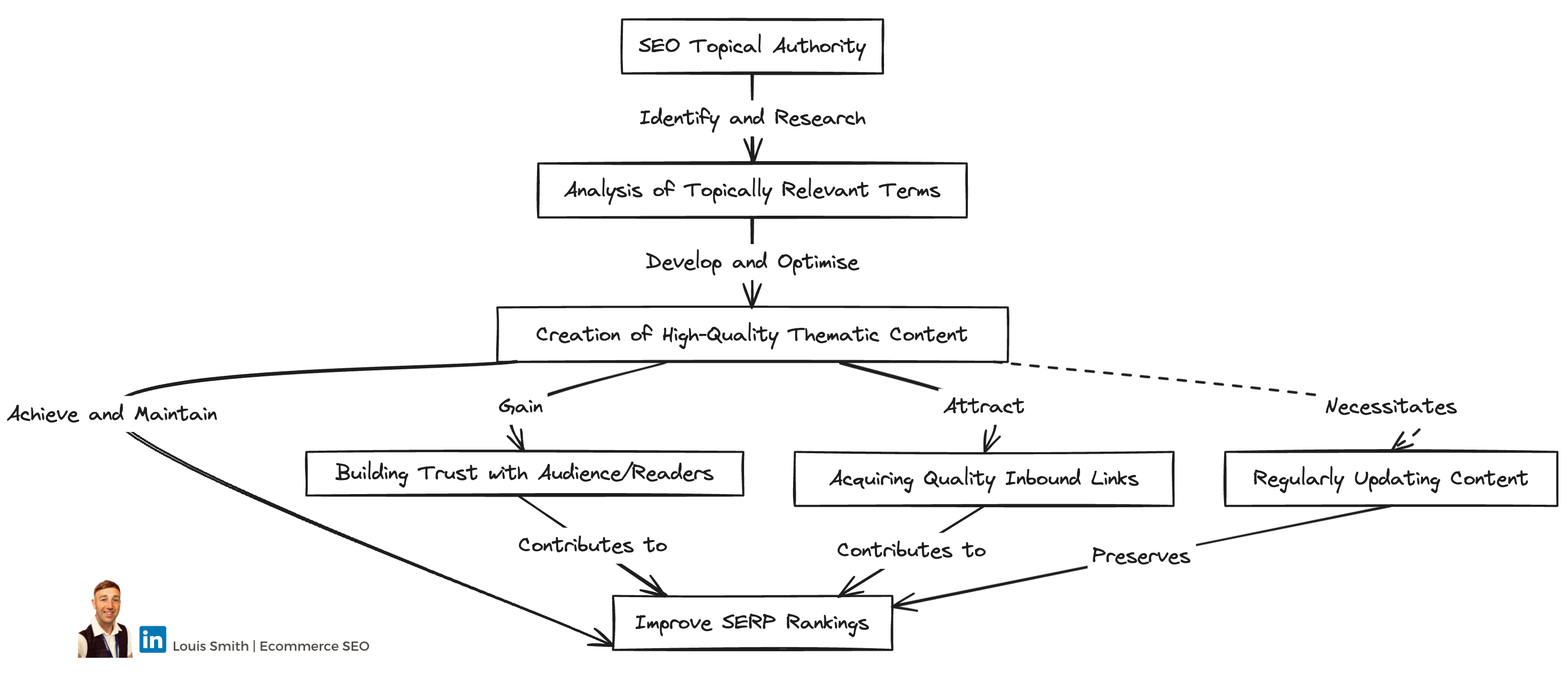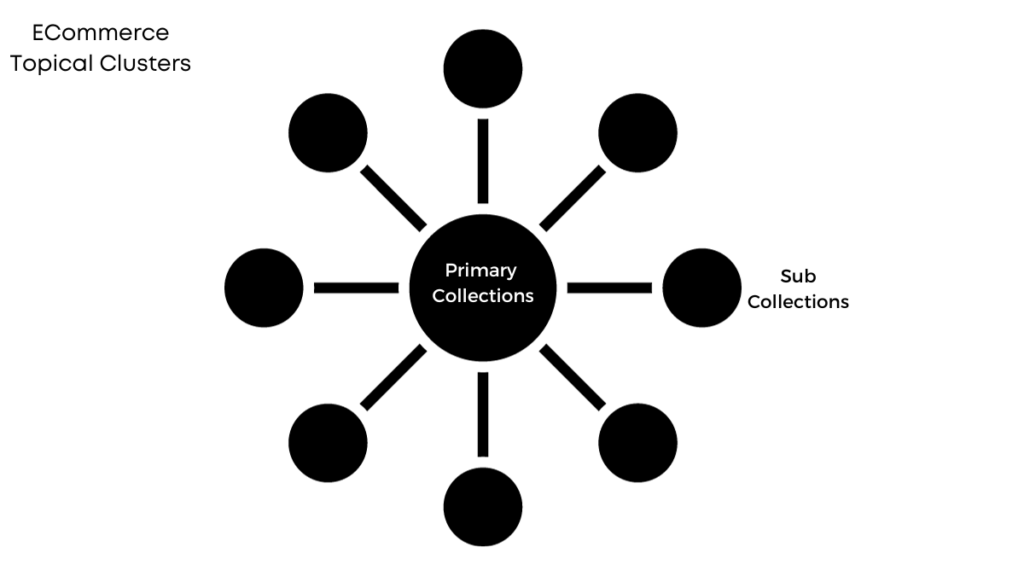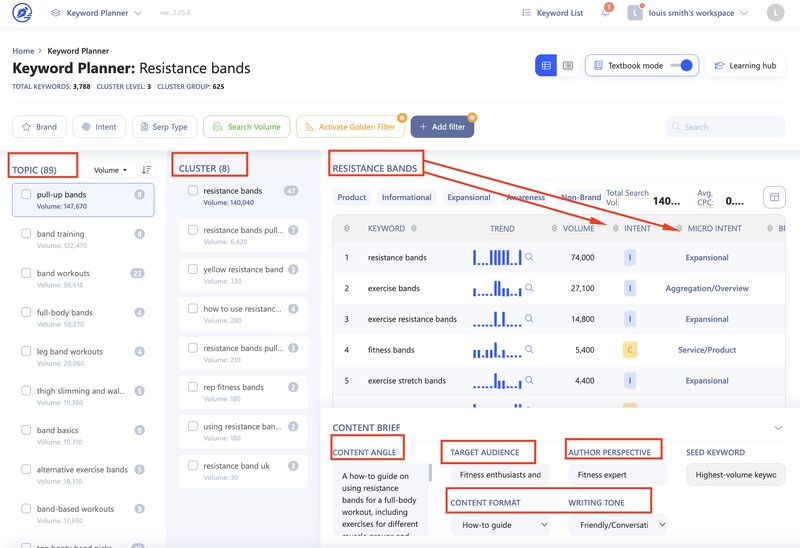How to Build Topical Authority (and Why They Matter)

You can improve traffic and conversions by creating intent-driven Topical E-commerce Keyword Clusters.
You want to build eCommerce topic clusters, right?
Intent-driven eCommerce product clusters and keyword intents will help create a lot of organic revenue with search. Interconnected pages covering a variety of subtopics under a single, overarching theme are known as SEO topic clusters. Not only may pages inside a topic cluster be accessible on a single main category page, but they also intelligently link to one another, assuming the reader knows what material they will be interested in engaging with your content.
Here’s the thing.
Marketing and SEO teams are always mindful of the need to make the most efficient use of their time, effort, and resources in order to maximise return on investment (ROI).
What is eCommerce topical authority cluster?

An e-commerce category page that arranges products into subcategories and provides links to those pages serves as one example. A content hub page that splits down different kinds of life insurance and provides links to blog pieces or guides about those subtopics would be another example.
To better your website’s SEO and user experience, use my strategy of content clustering. This approach improves your website structure for easier navigation. This also aligns your content more closely with what users are searching for. Here’s the benefits of content clustering:
- Enhanced User Experience and Conversion Potential: By implementing topic clusters, your website becomes easier to navigate. This gets visitors to relevant information seamlessly. This approach not only enriches the user experience but also strategically guides them through the customer journey, increasing the likelihood of conversions through well-placed internal links and relevant content.
- Streamlined Content Creation Process: Topic clusters simplify the content ideation phase. When you concentrate on covering various subtopics under a single main topic, it reduces the need for extensive brainstorming for new content ideas. While researching for one piece of content, you often uncover more ideas, streamlining future content development. Bingo!
- Organised and Accessible Website Structure: A well-structured website is important for your visitors and conversions. Content clustering organises your site, making it user-friendly. Also making it easier for visitors to find what they need and this reduces the chances of them leaving due to confusion or frustration.
- Robust and Focused Content Library: Building topic clusters allows you to create a comprehensive library on a specific subject, addressing a wide array of subtopics without overwhelming your audience. This method not only caters to the varied queries of your audience but also aligns with Google’s preference for content that addresses the needs of searchers, potentially boosting your site’s ranking.
Content clustering is a multifaceted strategy that significantly benefits SEO. It makes your website more user-friendly and organised, eases the content creation process, and leads to a more focused and deep content library. These factors collectively contribute to better search engine rankings and an improved overall online presence.
Tips for building your product topical hub and spoke model
Get intent right in 2023, and you’ll be doing better than 90% of competitors:
1) Intent keyword research for eCommerce marketing
The above title is an example of customers looking to buy on a page.
Let’s say 19,537 customers searching for a product to buy on your Shopify store.
Not all of them will have the same intent, right?
- 100% not every customer will have the same intent
- Poor intent matching = loss of revenue/traffic
- You need to match broad/micro intents
Breaking down your store into intents will super-charge your SEO strategy.
2) Growing revenue with keyword intent pillar page clusters
You should see a rise in website traffic and revenue if you are able to put your content at the top of search engine results pages (SERPs), using topical authority.
4 reasons to build revenue-driven content clusters:
- Solid Intent hierarchies “rockets” your conversion rates
- Customers need a well-labelled content architect
- Information hierarchy teaches Google crawlers
- 100% intent topic clusters win in SEO
3) The problems with eCommerce websites
Building topical authority is not easy!
Enterprise eCommerce websites have a lot of problems.
The popularity or staleness of a particular URL on the internet is referred to as crawl demand. By giving priority to the most important pages on your website, you can optimise your crawl budget and make sure that it isn’t being wasted on sites that are of poor quality or that you do not want to be indexed!
Here’s what you need to know:
- Internal linking intents become difficult with 10,000s of product SKUs
- Labelling intent clusters is not as simple as just creating silos
- Pages easily get digitally drowned in an ocean of problems
- It’s easy for customers to get confused and leave
- You lose revenue and traffic
4) Benefits of information intent architecture with UX
Encouraging consumers to find what they’re looking for in an eCommerce store such as a Shopify sto is by improving content findability is the ultimate goal of information architecture testing.
Two of the biggest obstacles to navigation, findability, and user experience are organising and labelling content.
There’s 4 more key benefits of information intent architecture with UX:
- Reduce the cost of direct support calls and emails
- Improve your site’s reputation and SEO ranking
- Increased customer engagement
- Reduce your marketing costs
5) Creating intent topic clusters
– Brands that cover this data will have better opportunities for ranking
– Your navigation needs to be analysed for cluster hierarchy benefits
– Google’s product knowledge graph is stuffed with data
– You should aim to cover a topic for 2023 SEO
See also; Is Keyword Research Important for Improving Discoverability?
What are the different types of clustering?

There’s various types of clustering.
In SEO, we refer to clustering as the common “hub and spoke” model.
If you’re super interested in clustering, check out the below models!
Types of Clustering:
- Centroid-based Clustering
- Density-based Clustering
- Distribution-based Clustering
- Hierarchical Clustering
How to create pillar page clusters?
To create your pillar page cluster, you need to build the hub and spoke model:
- Sign up for a cluster tool such as WriterZen
- Enter your target primary keyword
- Let the tool crawl the Google results
- Export your cluster model data
- Analyse your data
- Build out your topic cluster marketing strategy

The benefits of building topical clusters
This is real-world search:
- Help customers
- Kill deep websites
- Throw a lifeline to your products
This will help with your overall organic revenue!
You can read more on the 12 example of machine learning algorithms.
Final thoughts
Bad intent eCommerce architecture kills conversions and damages traffic.
Also, brands and SEO teams sometimes collide on how to label topic clusters.
Why? It comes down to your traffic and conversions.
Look.
📉 Customers operate with strange behaviour. Let’s not assume we know exactly how they will behave.
📈 Customers are clever. With a good intent architecture, your customers can easily find their desired products, which of course leads to conversion, bingo 🧠
We should never “assume” we have the “correct” intent architecture to match our customer’s goal for conversions.
Always conduct an eCommerce audit to find opportunties with your clusters.




